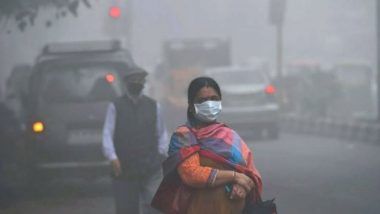New Delhi, October 15: In a bid to combat air pollution in the national capital, an emergency plan came into force on Monday. Under the emergency plan, stringent actions are implemented based on the air quality of the city. Delhi had adopted an emergency plan termed as Graded Response Action Plan (GRAP) last year under which stringent actions are implemented based on the air quality of the city. The emergency plan includes measures like mechanised sweeping of roads and deployment of traffic police to ensure smooth passage of traffic at vulnerable areas in the Delhi-NCR region.
Speaking at the launch, Union Minister Harsh Vardhan said that the early warning system will help in proactively forewarning, 3-4 days in advance, any large-scale air pollution events which may occur over the Delhi region. The System is designed to predict extreme air pollution events and give alerts to take necessary steps as per GRAP. Starting Monday, measures that have been implemented to improve air quality in Delhi include a ban on garbage burning, impounding of polluting vehicles and deploying traffic police for smooth flow of traffic at vulnerable points. Air Pollution Control Device 'WAYU' Installed at Two Spots in Delhi; Here's All About The Purifying Unit.
At present, the air quality is in the poor category, but authorities have predicted that it would reach the ‘very poor’ category in the next couple of days. Use of gensets have been banned under the Graded Response Action Plan but will not be banned in NCR because of power supply situation in the area, said Anumita Roychowdhury, a member of the Supreme Court-mandated Environment Pollution (Prevention and Control) Authority. Delhi and Mumbai among World’s Most Polluted: How Will Air Pollution Affect Our Mental and Physical Health?
- If the air quality lies in moderate to poor category- measures like stopping garbage burning in landfills and other places and enforcing all pollution control regulations in brick kilns and industries would be implemented, an official said.
- If the air quality falls in the very poor category, additional measures of stopping use of diesel generator sets, enhancing parking fees 3-4 times and increasing frequency of metro and buses would be implemented, he added.
- If the air quality falls in the severe category, additional measures would be implemented of increasing frequency of mechanised cleaning of roads, a sprinkling of water on roads and identifying road stretches with high dust generation.
- If the air quality falls to severe plus emergency category, then measures like stopping entry of trucks into Delhi (except essential commodities), stopping construction activities and appointment of a task force to take a decision on any additional steps, including shutting of schools, are implemented.
According to a report by PTI, in addition to GRAP, the CPCB has also deployed 41 teams across the Delhi NCR to monitor proper implementation of norms enforced to prevent pollution at the source. Till October 11, 96 inspections were conducted by the teams across Delhi NCR and the inspections would intensify in the coming days, a senior CPCB official said. The official further informed that the inspections were started by the two-member team on September 15.
The air pollution system has been developed jointly by the scientists at Indian Institute of Tropical Meteorology (IITM), Pune, India Meteorological Department and National Centre for Medium Range Weather Forecasting (NCMRWF).
In the last week, satellite images from the NASA showed rampant stubble burning activity in Punjab and Haryana. Meanwhile, NASA, on its official website, stated that burning of crop residue in Punjab and Haryana has increased significantly over the past 10 days in and near Amritsar, Ambala, Karnal, Sirsa and Hisar.
According to a PTI report, burning of paddy straw every year during October and November and wheat straw during April in Punjab and Haryana are the major contributors of air pollution in Delhi-NCR, as the smoke travels towards the national capital. In Delhi, it mixes with the fog and creates a toxic smoggy winter every year.
(The above story first appeared on LatestLY on Oct 15, 2018 06:44 PM IST. For more news and updates on politics, world, sports, entertainment and lifestyle, log on to our website latestly.com).













 Quickly
Quickly












